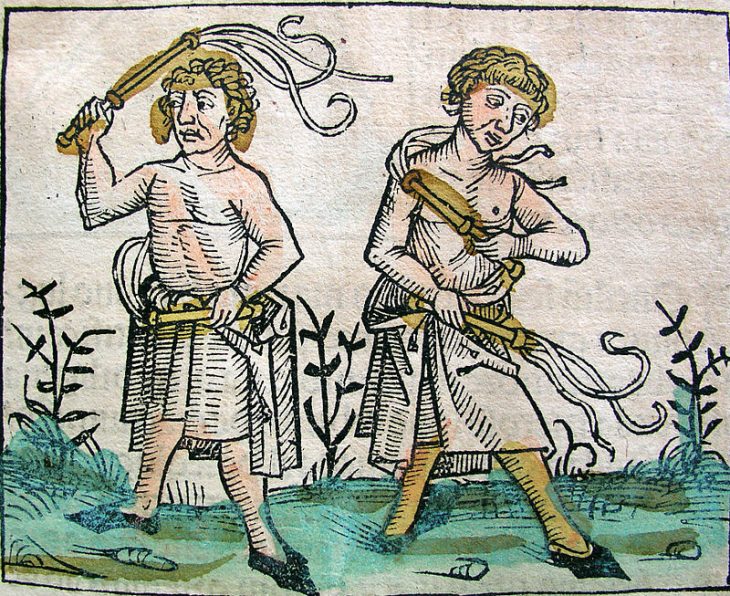
Word of the Day: Delinquent
Today’s word of the day, courtesy of the website Number2.com, is delinquent, an adjective meaning “failing in or neglectful of a duty or obligation; guilty of a misdeed or offense,” “(of an account, tax, debt, etc.) past due; overdue,” or “of or relating to delinquents or delinquency” (https://www.dictionary.com/browse/delinquent?s=t). Dictionary.com also says that it is a noun, meaning “a person who is delinquent,” or a “juvenile delinquent,” but I think it more proper to think of that as a substantive or substantive adjective, which is an adjective that is used as a noun (a nominal) rather than modifying a noun.
Interestingly, however, the word first entered English as a noun, according to www.etymonline.com, which says that it entered the language in the “late 15c., ‘one who fails to perform a duty or discharge an obligation,’ also, generally, ‘an offender against the law,’ a noun use from Latin delinquentum (nominative delinquens), present participle of delinquere ‘to fail; be wanting, fall short; do wrong, transgress, offend,’ from de- ‘completely’ (see de-) + linquere ‘to leave’ (from PIE root *leikw- ‘to leave’). As an adjective, ‘failing or neglectful in duty,’ from c. 1600 in English.” Of course, I think we hear the word most frequently as a nominal either with or without the modifier juvenile, and we think of juveniles even if we don’t use the modifier.
Yesterday I talked about the Black Plague, and today I’m going to continue talking about it but from a different point of view.
On this date in 1349, in the city of Erfurt, Germany, residents massacred somewhere between 100 and 3,000 Jews. This was not the first massacre of Jews, nor was it the last. The massacre was one of many inspired, as it were, by the Black Death. Sometimes these massacres happened in response to an outbreak of the plague, and sometimes then happened by the mistaken belief that such a thing would prevent the plague from manifesting. Sometimes these massacres were driven by local priests, but sometimes they were driven by flagellants.
Flagellants were a group of penitents arising in the fourteenth century. They practiced an extreme form of asceticism, whipping themselves (flagellation) as an act of repentance. The belief was that the plague, and the death that accompanied it, was a punishment from God, and the only way to prevent that punishment from God was to repent for the sins of the people, both individually and corporately. The movement peaked in 1349, during the Black Death, but disappeared almost as quickly as it arose. In October of 1349, Pope Clement VI officially condemned the sect. One of the reasons Clement condemned the flagellants was the “shedding the blood of Jews,” for which they were infamous (https://en.wikipedia.org/wiki/Erfurt_massacre_(1349)).
And the killing of Jews was not the totality of the enterprise. Looting frequently accompanied these massacres. In the case of Erfurt, the oldest surviving copy of a manuscript called the Tosefta, a compilation of oral law from the 2nd century CE. It is actually a supplement to the Mishnah, which is more like canon law to the Jews. The Tosefta came into the hands of the Erfurt City government, and then, by a roundabout way, eventually settled in the Berlin State Library.
But the Jews knew what to expect when the massacre began, and many of them hid their jewels. In one case, jewels were found in 1998 and are now referred to as the Erfurt Treasure.
While Pope Clement condemned the massacre of Jews, the fact is that it happened over and over, not just on this date in 1349. And it didn’t work. During a 10-week period in 1350, a year after the Erfurt Massacre, the plague struck the city and led to the deaths of an estimated 16,000 residents.
One would think that the leaders of cities like Erfurt and the priests of the Roman Catholic Church would have done a better job in persuading their subjects that the Jews were not responsible for the Black Death. But their ignorance caused them to be delinquent in their responsibilities, and the result was the deaths of many innocent people.
The image today is from the Nuremberg Chronicle, 1493, a woodcut of flagellants.